Note: If an image ever fails to appear - refresh your page, it really is there
Flags of International and Multi-National Organizations
In today's shrinking world International and Multi-National Organizations have a profound effect on our daily lives. These are the flags of a few of the more universally recognized of these huge organizations in the world today. Three of the largest, the UN, EU, and NATO, are covered in more detail on their own pages, all others share this page. The ICS also is covered on its own page.
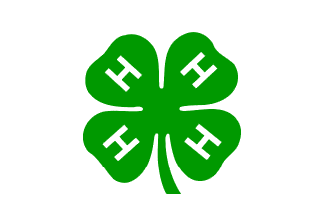
4-H Flag
|
4-H Club
The 4-H Clubs are an international association of young people from agricultural backgrounds. It attempts to encourage teaching sound agricultural practices, programs of agricultural vocational education (often in conjunction or cooperation with local schools), and a wide range of social activities. Presently 4-H is in 80 countries worldwide.
The 4H organization is administered in the United States by the United States Department of Agriculture with a national conference center in Chevy Chase, Maryland. Local chapters are run by the land grant colleges through the agriculture extension service (known as the Cooperative Extension Service). Projects developed by the children are often exhibited at the state and county fairs. The emblem of the organization is a green four-leaf clover with a white block letter H on each leaf.
|
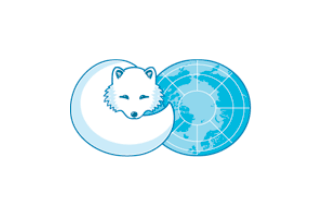
AC Flag
|
Arctic Council
The Arctic Council(AC) is a high-level intergovernmental forum which addresses issues faced by the Arctic governments and the indigenous people of the Arctic. The Ottawa Declaration of 1996 formally established the Arctic Council as a high level intergovernmental forum to provide a means for promoting cooperation, coordination and interaction among the Arctic States, with the involvement of the Arctic Indigenous communities and other Arctic inhabitants on common Arctic issues, in particular issues of sustainable development and environmental protection in the Arctic.
Member States of the Arctic Council are Canada, Denmark (including Greenland and the Faroe Islands), Finland, Iceland, Norway, Russian Federation, Sweden, and the United States of America.
|
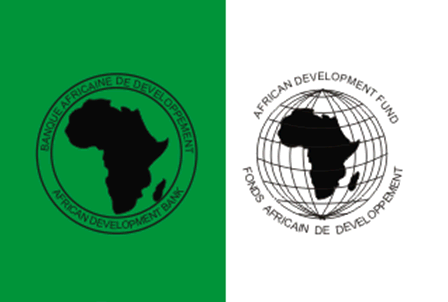
AfDB Flag
|
African Development Bank
The African Development Bank Group (AfDB) is headquartered in Tunis (Tunisia) and is a development bank established in 1964 with the intention of promoting economic and social development in Africa. AfDB provides loans and grants to African governments and private companies investing in the regional member countries in Africa. It is owned and funded by member governments, and has a public-interest mandate to reduce poverty and promote sustainable development.
The AfDB has a green-white vertical bicolor flag with a black map of Africa surrounded by a ring bearing its name in French and English on the green stripe. On the white stripe is another map of Africa, also in black, set on lines of latitude and longitude with the name of the African Development Fund, in English and French, written above and below.
|
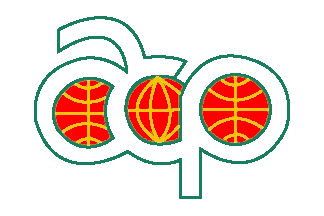
APC Flag 1975
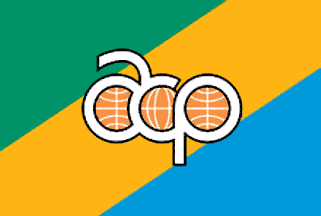
APC Flag 2013
|
African, Caribbean and Pacific Group of States
The African, Caribbean and Pacific Group of States (ACP) is a group of countries (currently 79: 48 African, 16 Caribbean and 15 Pacific), created by the Georgetown Agreement in 1975 (also known as the "ACP-EC Partnership Agreement"). The group's main objectives are sustainable development and poverty reduction within its member states, as well as their greater integration into the world's economy. The APC, sometimes called "The Lomé Convention," is basically a trade and aid agreement between the European Community (EC) and the 79 African, Caribbean, and Pacific (ACP) countries, first signed in February 1975 in Lomé, Togo.
In 1975, a white flag with green-outlined letters ACP, each containing a red globe with gold lines of latitude and longitude, was adopted by the African, Caribbean and Pacific Group of States.
The ACP Group unveiled a new flag and anthem at the opening ceremony of the ACP-EU Joint Parliamentary Assembly in 2013, to represent the solidarity and shared vision of its 79 member states. "Our flag consists of three diagonal bands of colour green, gold and blue. Green represents fertility and natural beauty and resources of our countries, gold symbolises the sun and the warmth of our people and blue symbolises the bodies of water that surround many of our nations, as well as the peace we all strive for," the Secretary General stated.
|
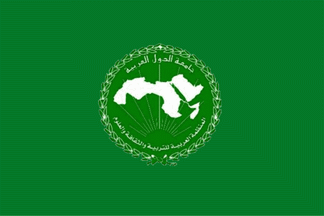
ALECSO Flag
|
Arab League Educational, Cultural and Scientific Organization
The Arab League Educational, Cultural and Scientific Organization (ALECSO), or the Organisation arabe pour l'éducation, la culture et les sciences, is a specialized agency having its headquarters in Tunis. The Organization, which works within the Arab League, is mainly concerned with enhancing and coordinating educational, cultural and educational activities in the Arab world. ALECSO was founded in accordance with Article 3 of the Arab Cultural Unity Charter and its creation was officially announced in Cairo in 1970. ALECSO includes 22 member states.
The ALECSO flag is green with its logo in the center of the flag. |
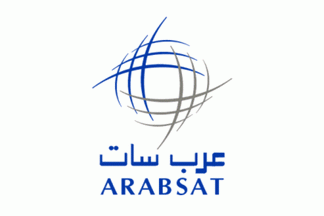
ARABSAT Flag
|
Arab Satellite Communications Organization
The Arab Satellite Communications Organization is a leading communications satellite operator in the Arab World, headquartered in the city of Riyadh (Saudi Arabia). It was established on 1976 by the member states of the Arab League with a defined goal of serving in telecommunication, information, culture and education sectors. Arabsat has operated the Arabsat GEO telecommunications system since its first satellite launch in 1985. ARABSAT owns and operates five satellites platforms at orbital positions. ARABSAT was created to deliver satellite-based, public and private telecommunications services to the Arab States, in accordance with International Standards. With more than 20 member countries, the organization plays a vital role of enhancing communications in the Arab World.
It flag is white with its logo. It is a stylized globe indicating by blue and grey longitude and latitude lines. Under the globe, there is Arabic and and English name of the organization.
|
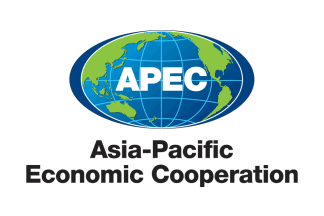
APEC Flag
|
Asia-Pacific Economic Cooperation Council
The Asia-Pacific Economic Cooperation (APEC) was established in 1989 in response to the growing interdependence among Asia-Pacific economies. APEC has become the primary international organization that promotes open trade and economic cooperation among its 21 members around the Pacific Rim.
APEC’s goal is to advance Asia-Pacific economic dynamism and sense of community. Asia-Pacific is one of the fastest growing regions in the world and a major contributor to global prosperity and stability. APEC's members have a combined population of over 2.4 billion inhabitants, that imported goods worth more than 2.6 trillion dollars in 1999, and its Gross Domestic Product hit US$16 trillion in 1998). Mexico is the APEC Chair for the year 2002.
|
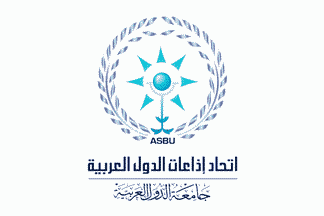
ASBU Flag
|
The Arab States Broadcasting Union Flag
The Arab States Broadcasting Union (ASBU), founded in 1969, is an Arab joint-action institution related to the League of Arab States and the Pan-Arab Association of Public Service and Commercial Broadcasters based in Tunis. It was established in February 1969 in Khartoum, with the objective of "strengthening ties and promoting cooperation among broadcasters in the Arab States for better production and content development." Grouping all the Arab governmental radio and television corporations, ASBU has kept abreast of all the evolutions that took place in the audiovisual field in the Arab world.
Its headquarters are located in Tunis, Republic of Tunisia. It flag is white with its logo placed in the center of the flag.
|
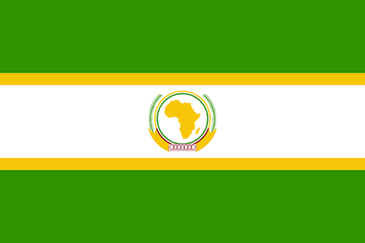
OAU Flag
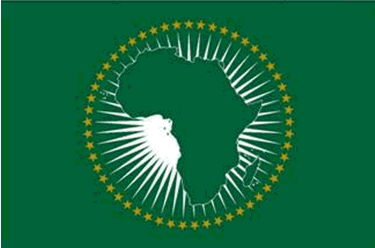
AU Flag
|
African Union (AU)
The African Union is a union of 54 African states with its headquarters in Addis Ababa (Ethiopia) and is the successor to the Organisation of African Unity (OAU). The OAU was founded in 1963, but it was only in 1970 that the flag was adopted.
The African Union (AU) was launched in Durban, South Africa, in 2002 and hoisted a new flag on 30 January 2010. The new flag has a dark green map of the continent superimposed on a white stylized sun with 53 points - the number of member states at the time of its adoption. Surrounding the central emblem are 53 gold five pointed-stars - one for each member state. The only African state not a member of the AU is Morocco due to the dispute over the Western Sahara and its membership as the Sahrawi Arab Democratic Republic.
The flag of the OAU was a horizontal triband of green, white and green, with the bands separated by narrow gold stripes. In the center is a map of Africa in gold, within a green and gold wreath. There are seven interlocking red rings at the base. The green is for the vegetation of sub-Saharan Africa and the gold is for the deserts of the north. The white stands for peace and unity. It may be surprising that black is not included, but the reason is that not all Africans are black and it was intended that the flag should avoid even the smallest suggestion of racism.
|
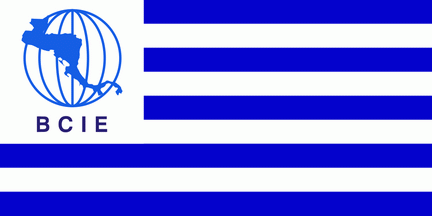
CABEI - BCIE Flag
|
Central American Bank for Economic Integration
In 1960, five Central American nations founded the Central American Bank for Economic Integration (CABEI), also called Banco Centroamericano de Integración Económica (BCIE). It is the largest financial institution in Central America, whose goals are to help fight against poverty, encourage regional integration, and the competitive insertion of Central America in the global economy. Working together with the countries of Central America, Mexico, Argentina, Colombia, Spain, and the Republic of China, the Bank works to support the transforming of Central America into a prosperous and united region. It has promoted social programs, developing economic, social, education, and health related institutions in these countries.
Its flag consist of blue and white horizontal stripes with a white canton defaced by a stylized globe on which is superimposed by a blue map of Central America. The Spanish abbreviation of the organization is written under the emblem.
|
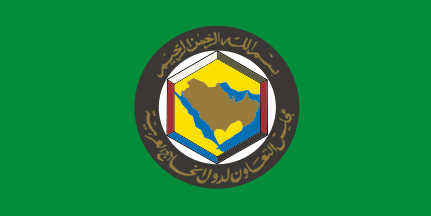
CCASG Flag
|
Cooperation Council for the Arab States of the Gulf
The Cooperation Council for the Arab States of the Gulf (CCASG), also known as the Gulf Cooperation Council (GCC), is a political and economic union involving six Arab states of the Persian Gulf with many economic and social objectives, including many joint ventures in the areas of finance, trade, customs, tourism, legislation, industry, mining, agriculture, water and animal resources, and including an unified military presence. Not all of the countries neighbouring the Persian Gulf are members of the council; Iran and Iraq are currently excluded, although both nations have a coastline on the Gulf.
The CCASG was established in 1981, and its member States are Bahrain, Kuwait, Oman, Qatar, Saudi Arabia, and the United Arab Emirates.
|

CCNR Flag 1920
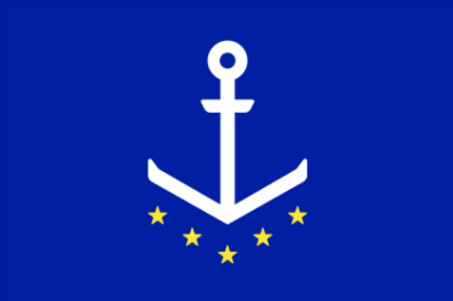
CCNR Flag 2015
|
Central Commission for Navigation on the Rhine
The Central Commission for Navigation on the Rhine (CCNR) was created in 1816 following the Congress of Vienna and is considered to be the oldest international organization still in existence. Its membership includes most of the countries bordering the Rhine River in Western Europe. They currently are Belgium, France, Germany, the Netherlands, and Switzerland. Italy was a member of the commission from 1919 to the Second World War, and the United States was temporarily a member immediately after World War II while Germany was under Allied occupation. The United Kingdom became a member from 1919 to 1993, but is now a member-observer, leaving the current five. The main objective of the CCNR is to promote navigation on the Rhine throughout Europe and guarantee a high degree of safety for its navigation while protecting its environment. Since 1920, the Central Commission for Navigation on the Rhine has been headquartered in the former Imperial Rhine Palace, located in the Republic Square of Strasbourg.
For years the flag of the commission with six yellow stars flew on the first floor of the Rhine Palace, but in 2015, a new simplified version of the commission flag with five stars replaced the older flag. Its central emblem remains an anchor to emphasize that its prime task remains ensuring "the freedom of navigation on the Rhine" which its five member states, symbolized by the stars following the shape of the anchor, undertook to uphold by signing the historical final Act of the Congress of Vienna in 1815. |
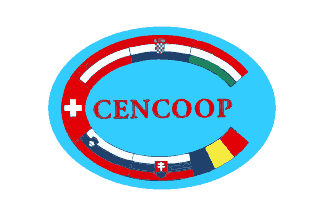
CENCOOP Flag
|
Central European Nations Co-operation in Peace Support
The Central European Nations Co-operation in Peace Support (CENCOOP) is a multinational programme of activities of smaller nations located in Central Europe, in accordance with the Charter of the United Nations and is based on decisions of the United Nations, the principles of the EU, and the objectives of the European Security and Defence Policy (ESDP), as well as the Partnership for Peace initiative (PfP). CENCOOP is to improve the capabilities of the Central European Nations (CEN) in order to respond more effectively to Peace Support challenges and achieve a higher profile through regional cooperation. CENCOOP is based on the terms of the Partnership for Peace Programme. Each country participates within the terms as stated individually in PfP.
Its flag is white with its light-blue oval emblem, with flags of member states and with its abbreviation in red. Flags are formed in letter C.
|
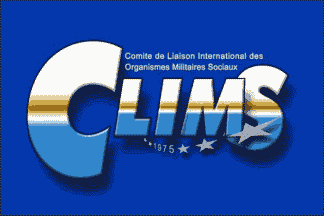
CLIMS Flag
|
Liaison Committee of Social Military Organizations
The Liaison Committee of Social Military Organizations (Comité de Liaison International des organismes Militaires Sociaux) is an international group whose purpose is to develop multi-cultural youth exchanges and family vacations between the Ministries of Defences of the member countries. The CLIMS has been created in 1975. It includes militaries in 13 countries: Germany, Belgium, Spain, France, Italy, Hungary, the Netherlands, Poland, Portugal, Czech Republic, Bulgaria, Romania and Greece.
The CLIMS flag is blue with its logo placed in the center of the field. It consists of abbreviation of its name, which is divided white over light blue. There is full French name over the abbreviation, and stars and foundation year are placed under the abbreviation.
|

CMBO Flag
|
The Colombo Plan
The Colombo Plan for Cooperative Economic and Social Development in Asia and the Pacific was conceived at the Commonwealth Conference on Foreign Affairs held in Colombo, Ceylon (now Sri Lanka) in 1950. It has grown from a group of seven Commonwealth nations - Australia, Britain, Canada, Ceylon, India, New Zealand and Pakistan - into an international organization of 26, including non-Commonwealth countries.
The Colombo Plan was instituted as a regional intergovernmental organization for the furtherance of economic and social development of the region` nations. It is based on the partnership concept for self-help and mutual help in the development process with the focal areas being, human resource development and south-south cooperation.
The current Colombo Plan flag has a blue field with coloured emblem placed on a white disc in the middle of the flag.
|

CTA Flag
|
Technical Centre for Agricultural and Rural Cooperation
The Technical Centre for Agricultural and Rural Cooperation ACP-EU (CTA) was established in 1983 under the Lomé Convention between the ACP countries and EU member states. Since 2000 CTA has operated within the framework of the ACP-EU Cotonou Agreement with a mission to â01Cstrengthen policy and institutional capacity development and information and communication management capacities of ACP agricultural and rural development organisations. It assists such organisations in formulating and implementing policies and programmes to reduce poverty, promote sustainable food security, preserve the natural resource base and thus contribute to building self-reliance in ACP rural and agricultural development.
It is headquartered in Wageningen, the Netherlands. Its flag is white with its logo and the initials CTA in black.
|
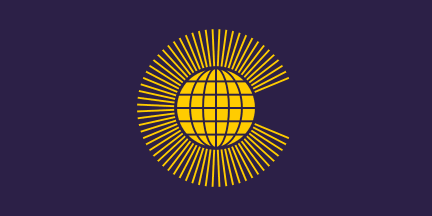
Commonwealth Flag
|
Commonwealth of Nations 1976
The Commonwealth of Nations is a worldwide political organization of independent nations with their dependencies, all of which recognize the Queen Elizabeth II as head of the Commonwealth.
The Commonwealth describes itself as an association of states that have experienced direct or indirect British rule or have been otherwise administratively linked to another Commonwealth country, with the exception of Mozambique which was admitted in recognition of its contribution to the struggle against apartheid in South Africa.
|
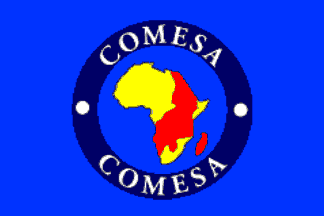
COMESA Flag
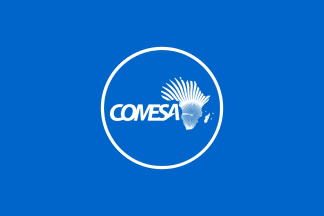
COMESA Flag c2010
|
Common Market for Eastern and Southern Africa
The Common Market for Eastern and Southern Africa (COMESA) is a free trade area consisting of nineteen member states stretching from Libya to Zimbabwe. COMESA was first formed in 1994, replacing an earlier Preferential Trade Area (PTA) which had existed since 1981. Nine of the member states formed a free trade area in 2000 (Djibouti, Egypt, Kenya, Madagascar, Malawi, Mauritius, Sudan, Zambia and Zimbabwe), with Rwanda and Burundi joining in 2004 and the Comoros and Libya in 2006. In 2008, COMESA agreed to an greater expanded free-trade zone which included members of two other African trade blocs, the East African Community (EAC) and the Southern Africa Development Community (SADC). The headquarters of COMESA are in Lusaka (Zambia) while that of the COMESA Bank is in Bujumbura (Burundi) and the Clearing House remains in Harare (Zimbabwe).
Since the inception of the PTA, the institution has used a map of Africa with its member states highlighted as its logo. The logo of COMESA remains a map of Africa showing its member countries surrounded by a thick black ring with COMESA written both at the top and bottom. Their flag has evolved as the logo has evolved. The flag is blue with the logo in the center. The map of Africa is in yellow with the member states being shown in red. The name of the institution appears in white on the inner, thick black ring.
The newest flag of CIMESA, which began to appear in 2010 is light blue with stylized map of Africa and its abbreviation next to it. All elements are white. The emblem is placed inside a white circle on the flag.
|
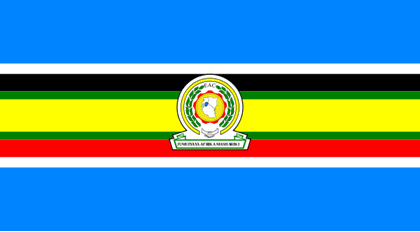
EAC Flag
|
East African Community
The East African Community (EAC) is an inter-governmental organisation comprising five countries in East Africa: Burundi, Kenya, Rwanda, Tanzania and Uganda. The organisation was originally founded in 1967 comprising Kenya, Uganda and Tanzania, but collapsed in 1977 as a result of political differences. It was officially revived in 2000 and seeks to promote full economic integration amongst its members.
The flag of the EAC comprises 9 horizontal stripes of unequal width. The first and last are the thickest and are in blue. A thinner white stripe separates the blue from a black stripe and red stripe at the top and bottom of the flag. These stripes in turn are separated by a thin green stripe from the middle, thicker, yellow stripe. The colour order of the stripes is therefore: blue, white, black, green, yellow, green, red, white and blue.
In the centre of the flag in the middle of the yellow stripe (extending across the green and into the black and red stripes) is the badge of the EAC The motto of "ushirikiano wa afrika mashariki" at the base means "Unity of East Africa in Swahili."
|
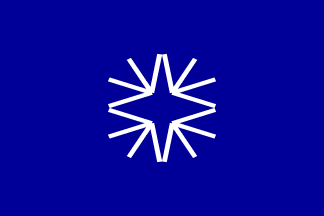
EAPC Flag
|
Euro-Atlantic Partnership Council 2001
The Euro-Atlantic Partnership Council (EAPC) was a multilateral forum created by NATO to improve relations between NATO and non-NATO countries in Europe and parts of Asia near Europe. The member states meet to cooperate and consult on a range of political and security issues.
According to Lord Robertson's speech opening the December 2001 EAPC meeting and introducing the new flag the flag was designed by Janis Krievs from Latvia as part of an international competition.
|
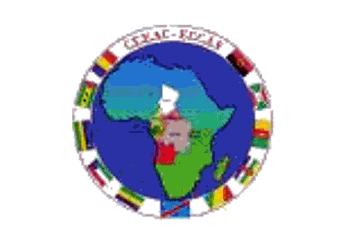
ECCAS Flag
|
Economic Community of Central African States
The Economic Community of Central African States (ECCAS) is an economic community of the African Union for the promotion of regional economic co-operation in Central Africa which was established in 1966. It "aims to achieve collective autonomy, raise the standard of living of its populations and maintain economic stability through harmonious cooperation".
It has a plain white flag with its logo in the centre. The logo has a map of Africa with the member countries highlighted and the flags of the member states surrounding it.
|
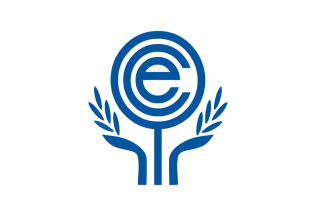
ECO Flag
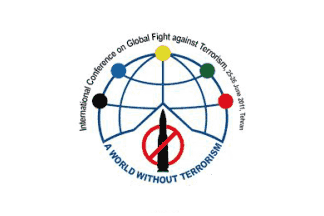
A World Without Terrorism Flag
|
Economic Cooperation Organization
The Economic Cooperation Organization is a regional organization established in 1985 by Iran, Pakistan and Turkey for the purpose of promoting economic, technical and cultural cooperation among the member states. It was the successor of the Regional Cooperation for Development (RCD) which ended activities in 1979. In 1992, the ECO was expanded to include seven new members (Afghanistan, Azerbaijan, Kazakhstan, Kyrghyzstan, Tajikistan, Turkmenistan, and Uzbekistan).
The Economic Cooperation Organization Flag features the stylized blue initials "e" surrounded by a "C" and then a "O", all of whom are balanced on a blue shaft. On either side of the shaft are two stylized wheat stocks resembling two supporting hands. The whole composition seems to mimic a United Nations sponsored organization flag.
The second flag is the "A World Without Terrorism" Conference flag, a controversial event hosted by the Iranian government, originally an initiative of the ECO, in Tehran in June of 2011. The published goals of the two-day "A World without Terrorism" conference were to discuss terrorism and identify its main causes. However, the conference soon became a blatant attempt by the sponsoring Iranian government to reassert itself as the leading regional Islamic leader in the area. The conference simply become a stage to cast stones at Israel, the United States, and the United Kingdom, claiming it was they who had "a black record of terrorist behaviors."
|
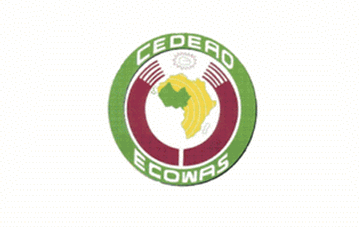
ECOWAS Flag
|
Economic Community of West African States
The Economic Community of West African States (ECOWAS) is a regional group of fifteen West African countries which was established on 28 May 1975. Its mission is to promote economic integration across the region. It flies a plain white flag with its emblem in the centre, surrounded by a green ring on which is written its acronym in French and English.
|
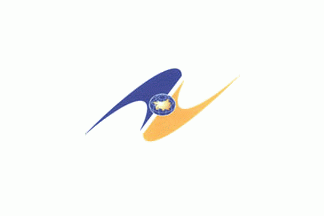
EURASEC Flag
|
Eurasian Economic Community
This is the flag of the Eurasian Economic Community (EURASEC), an organization which formed in 2001. The members are Russia, Belarus, Kazakhstan, Kyrgyzstan and Tajikistan.
The logo centered on the plain white field frames a map that represents all the member countries.
|
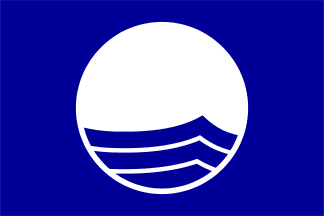
FEEE Flag
|
Foundation for Environmental Education
This Blue Flag is awarded by the Foundation for Environmental Education in Europe (FEEE). The Blue Flag is a widely recognised eco-label. This is awarded to beaches and marinas where environmental protection is a high priority in site management and information encourages care for the environment.
The blue flag started out in France in 1985, under the initiative of a few French coastal municipalities. In 1987, the Blue Flag Campaign was officially launched by the European Commission, under proposition (and management) of the FEEE, within the activities of the European Year of the Environment, that happened that year. In 2004, 2333 beaches and 605 marinas flew the blue flag in 29 countries from Europe, the Caribbean and South Africa. It is also flown in Canada, New Zealand, Chile, Barbados, Morocco and Poland.
|
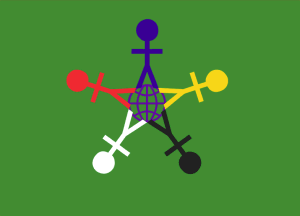
Children's Day Flag
|
International Children's Day 1925
International Children's Day had its origin in the World Conference for the Well Being of Children in Geneva in 1925. Because of this International Children's Day, is widely celebrated on June 1. This, of course, coincided with the conference, however, each country can chose its own day to commemorate it.
The flags design forms a star, which is made up of five colored stick figures. The five points on the star thus formed represents the continents with a stylized globe directly in the center. The field is green.
|
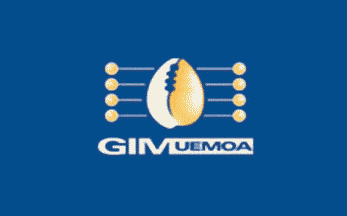
GIM-UEMOA Flag
|
Inter-banking Monetary Group of UEMOA
The Inter-banking Monetary Group of UEMOA (Groupement interbancaire monétique de UEMOA) is an international financial organization of regional banks and monatary systems located in West Africa that was established in 2003. It provides standardization for interbanking monetary system between the member countries, and provides the monetary services for payments between banks, portal services and micro financial systems. It encourages the use of bank cards within UEMOA payments. Currently there are 91 banks and financial institutions within the UEMOA (West African Economic and Monetary Union/Union économique et monétaire ouest-africaine) which includes the countries of: Benin, Burkina Faso, Côte d’Ivoire, Mali, Niger, Senegal, and Togo.
The GIM-UEMOA flag is blue, with its logo forming a chip on a bank card together with letters GIM UEMOA.
|
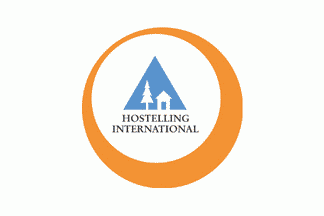
HI Flag
|
Hostelling International
The Hostelling International, formerly known as International Youth Hostel Federation (IYHF), is the federation of more than 90 national youth hostel associations in more than 80 countries who have over 4,500 affiliated hostels around the world. The youth hostel movement was begun in 1909 by Richard Schirrmann, a German schoolteacher, and Wilhelm Münker, a conservationist, who saw the need for overnight accommodation for school groups so that they could experience the countryside. The first Jugendherberge (youth hostel) was opened in Schirrmann's own school, in Altena, Westphalia. Schirrmann founded the nationwide German Youth Hostel
Today, the Hostelling International also facilitates youth work and international and cross cultural understanding in conjunction with UNESCO. Their flag is a white horizontal background with the logo in the middle. |
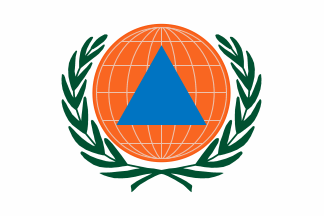
ICDO Flag
|
International Civil Defence Organization
The flag of the International Civil Defense Organisation (ICDO) was first used at the 38th ICDO Executive Council meeting held in Geneva, Switzerland in 2005. The emblem of the ICDO as used on the flag, features an orange globe with white longitude and latitude lines throughout on which is placed a blue equilateral triangle. The blue triangle on an orange field is the distinctive sign of Civil Defence as spelt out in the 1977 Protocols to the 1949 Geneva Convention. The globe and triangle is completed with green laurels[3]. The ICDO emblem is placed on a white field when used as a flag.
|
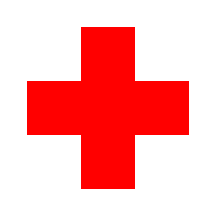
ICRC Flags
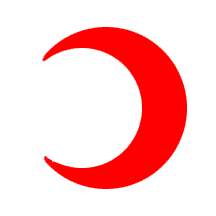
|
International Federation of the Red Cross
International Red Crescent Society
The International Movement of the Red Cross is composed by the International Committee of the Red Cross, the International Federation of Red Cross and Red Crescent Societies and the National Red Cross and Red Crescent Societies.
|
|
|
The Red Lion and Sun |
|
Federation of Red Cross and Red Crescent |
In 1864 the Geneva Convention adopted the red cross on a white ground as the officially recognized sign of the medical services of armed forces. In 1876, however, the Ottoman Empire decided to use a red crescent on a white ground in place of the red cross. Persia subsequently chose a red lion and sun on a white ground. In 1949 these signs were confirmed as the emblems of the red cross, the red crescent and the red lion and sun on a white ground as the protective signs for army medical services.
|
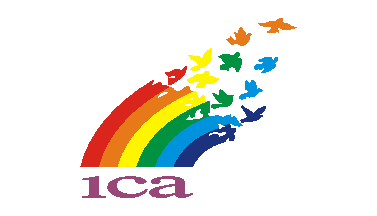
ICA Flag
|
International Co-operative Alliance Organization
The International Co-operative Alliance (ICA), established in 1895, is based in Geneva. The ICA is an independent non-governmental association which unites, represents and serves co-operatives world wide. Its members are national and international co-operative organisations in all sectors of activity including agriculture, banking, credit and saving, industry, insurances, fisheries, housing, tourism and consumer co-operatives. ICA has more than 200 member organisations from over 100 countries, representing more than 700 million individuals world-wide
.
In 1946 it was one of the first non-government organisations to be accorded United Nations Consultative Status. Today, it is one of the 41 organizations holding Category 1 Consultative Status with UN Economic and Social Council (ECOSOC).
|
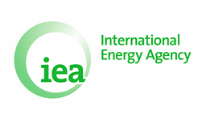
IEA Flag
|
International Energy Agency
The International Energy Agency (IEA) is an autonomous organization which works to ensure reliable, affordable and clean energy for its 28 member countries and beyond. Founded in response to the 1973-19744 oil crisis, the IEA´s initial role was to help countries co-ordinate a collective response to major disruptions in oil supply through the release of emergency oil stocks to the markets. While this continues to be a key aspect of its work, the IEA has evolved and expanded. It is now at the heart of global dialogue on energy, providing authoritative and unbiased research, statistics, analysis and recommendations.
The IEA is headquartered in Paris, France. The only reported flag for the IEA has a basic white background with the IEA logo and green text centered on the field as shown.
|
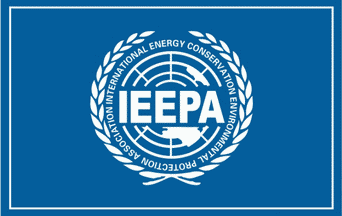
IEEPA FlagNOTE: The IEEPA should not be confused with the International Emergency Economic Powers Act (also IEEPA) of 1977, which is a U.S. federal law authorizing the Presidents to regulate commerce after declaring a national emergency in response to any unusual and extraordinary threat to the United States which has a foreign source. |
International Energy Conservation Environmental Protection Association
The International Energy Conservation Environmental Protection Association (IEEPA) is a global institution focused on economic and social construction of energy conservation and environmental protection. The IEEPA is headquartered in the Peoples Republic of China, and although a non-government organization, it does have close ties with the PRC government in an advisory position.
Although its flag has a field of "UN" blue and its emblem in white in the middle of the flag is very "UN" looking, it is not an official part the United Nations, but does work with the United Nations and other international organizations. For example, the IEEPA, working in partnership with the United Nations Industrial Development Organization (UNIDO), organizes the World Environmental Conference (WEC) every year. The conference as a platform for world leaders, experts, and enterprises to discuss the world climate issues and developing a green sustainable economy. |
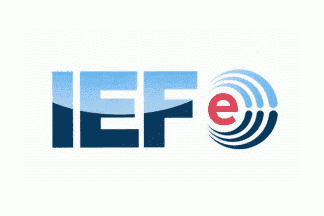
IEF Flag
|
International Energy Forum 2011
The International Energy Forum (IEF), consisting of 86 countries, is now the world´s largest organization of oil and energy producing coutries. The IEF controls more than 90% of global oil and gas supply and demand. In addition to IEA and OPEC countries, transit states and key energy players, including Brazil, China, India, Mexico, Russia and South Africa, participate in the Forum. Through the Forum and its associated events, IEF Ministers, their officials, energy industry executives, and other experts engage in a dialogue of increasing importance to global energy security.
The IEF, and a permanent Secretariat and international staff, is based in the Diplomatic Quarter of Riyadh, Saudi Arabia. Their IEF flag has a white field with its logo centered on it.
|
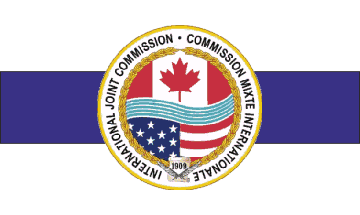
IJC/CMI Flag
|
International Joint Commission
Commission Mixte Internationale
The International Joint Commission was formed between the United States and Canada as part of the Boundary Waters Treaty, signed by the two neighboring countries in 1909. Because of the many lake and river systems along what is today the longest unprotected (militarily) border in the world, the two countries recognized the need to cooperate in protecting these natural resources. The IJC approvals and makes decisions on projects, such as dams and diversions, that affect the natural level and flow of water across the boundary. Theses areas of responsibilities include a wide range of water uses, including drinking water, commercial shipping, hydroelectric power generation, agriculture, industry, fishing, recreational boating and shoreline property.
The International Joint Commission Flag is a simple horizontal white-blue-white tricolor with the IJC logo centered on it. The IJC's name, appearing in both English and French, encircles stylized Canadian and American National flags (on their respective sides) of a stylized wavy blue river on the logo. The IJC's founding date of "1909" is placed below the logo in a encircling golden wreath design.
|
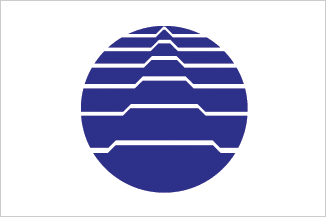
BIE Flag
|
International Exposition Bureau
Bureau International des Expositions
The International Exposition Bureau (BIE - Bureau International des Expositions) is an international organization that sanctions special expositions called international World Expos, or more commonly, "World's Fairs."
The idea of a World's Fair originated in France, which had a tradition of national exhibitions, and the French Industrial Exposition of 1844, held in Paris, is considered the first World's Fair. The BIE organization itself was established at an international convention held in Paris in 1928.
|
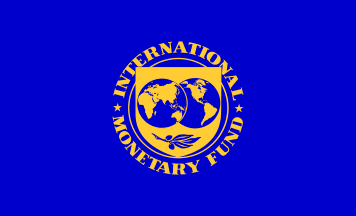
IMF Flag
|
International Monetary Fund
The International Monetary Fund (IMF) is the intergovernmental organization that oversees the global financial system by following the macroeconomic policies of its member countries, in particular those with an impact on exchange rate and the balance of payments. It has 187 member states, working to foster global monetary cooperation, secure financial stability, facilitate international trade, promote high employment and sustainable economic growth, and reduce poverty around the world. Its stated objective is stabilizing the international exchange rates. It also offers loans, mainly to poorer countries.
The International Monetary Fund headquarters are in Washington, D.C. The IMF's flag is dark blue with its golden emblem on it.
|

Interpol Flag
|
International Criminal Police Organization 1923
Interpol, whose full name is the International Criminal Police Organization, is an organization facilitating international police cooperation. It was established as the International Criminal Police Commission in 1923, and has its headquarters in St-Cloud, outside Paris.
Interpol has currently 181 members. The sovereign countries not members of Interpol are: Bhutan, Kiribati, North Korea, Micronesia, Palau, Samoa, San Marino, Solomon Islands, Taiwan, Tajikistan, Turkmenistan, Tuvalu, Vanuatu and Vatican.
|
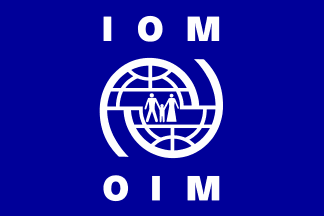
IOM Flag
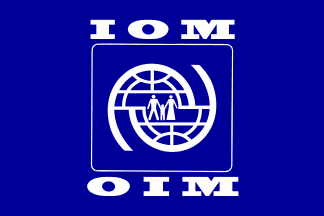
IOM Flag (variant)
|
International Organization for Migration
Organisation Internationale pour les Migrations (French)
Organización Internacional para las Migraciones (Spanish)
The International Organization for Migration (IOM) was initially established in 1951 as the Intergovernmental Committee for European Migration (ICEM) to help resettle people displaced by World War II. It is the principal intergovernmental organization in the field of migration. IOM is dedicated to promoting humane and orderly migration for the benefit of all. It does so by providing services and advice to governments and migrants. IOM works to help ensure the orderly and humane management of migration, to promote international cooperation on migration issues, to assist in the search for practical solutions to migration problems and to provide humanitarian assistance to migrants in need, be they refugees, displaced persons or other uprooted people.
Its flag is blue with its white logo in the middle of the flag, and its English and French abbreviations are placed above and under the logo. Its blue field is darker than the UN blue. There are two variants of the flag. The current one is with abbreviation of Arial font, and the other one is with a Times. The other difference is a rounded square around the logo. While the current logo is without the thin square and uses the Arial font, the other version is a former variant, but still in use. |
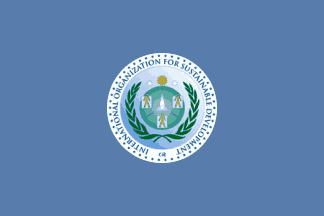
IOSD Flag
|
Intergovernmental Organization for Sustainable Development
The Intergovernmental Organization for Sustainable Development (IOSD) began in 2006 as a non-profit organization with a mandate to administer the Euclid University Extension program and also develop and implement other programs related to sustainable development. In 2008, the IOSD was absorbed into EUCLID and now IOSD and EUCLID share officers and offices. Euclid University (EUCLID) is an intergovernmental non-profit institution chartered as a university and umbrella organization dedicated to sustainable development. The mission of the International Organization for Sustainable Development is to foster the well-being of all human beings by promoting sustainable economic development, inter-cultural dialogue, and facilitating access to world-class higher education, especially in the developing nations of Africa and the Pacific.
The IOSD flag is light blue with its emblem placed on a white disc in the center of the flag.
|
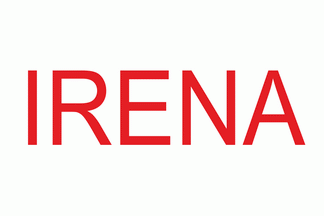
IRENA Table Flag 2010
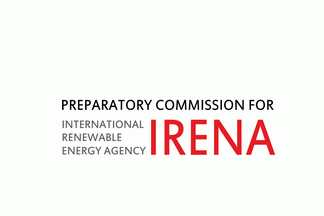
Preparatory Commission Flag
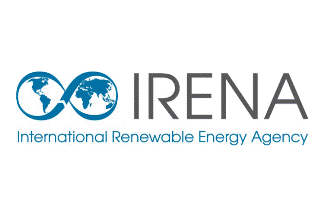
IRENA Flag 2011
|
International Renewable Energy Agency 2010
The International Renewable Energy Agency (IRENA), with headquarters in Abu Dhabi, is an intergovernmental organization for promoting the adoption of renewable energy worldwide. The European Union and 148 countries are signatories of the statute.
The International Renewable Energy Agency (IRENA) was officially established in Bonn in January of 2009. At the Founding Conference 75 States from all over the world signed the Agency's Statute. The founding of IRENA was preceded by several preparatory meetings that paved the way for establishing the Agency.
Although no official flag had been approved, at the 4th Session of the IRENA preparatory commission in 2010, a plain white table flag with "IRENA" in capital red letters was displayed on each table.
Because IRENA's official logo has the red letters of IRENA combined with their full name in grey, also reported at various meetings of the Preparatory Commission is a variant of the table flag with the Preparatory Commission's title above the logo in black letters.
In 2011, the International Renewable Energy Agency approved a new logo and flag during the fifth session of the Preparatory Commission and the first session of the IRENA Assembly in Abu Dhabi, United Arab Emirates (UAE).
Adnan Amin, Director-General of IRENA, explained that the Preparatory Commission engaged a professional designer to create a logo for the Agency. He said the proposed logo aimed to represent the infinite nature of renewable energy and its worldwide scope. He also noted that a new blue color was proposed. The Assembly approved the new logo and color by consensus.
|
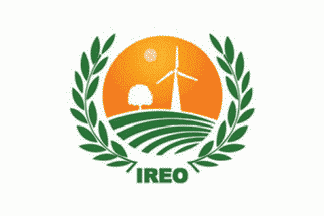
IREO Flag
|
Intergovernmental Renewable Energy Organization
The Intergovernmental Renewable Energy Organization (IREO) is an intergovernmental organization that works to promote the use of affordable, clean sources of renewable energy worldwide. It strives to make Alternative Renewable Energy sources a key-driver to eradicate the current depletion of our environment by the use of fossil fuels that has led to the climate change and energy crisis due to high prices and other factors we are now facing. IREO strives to achieve global energy security, and bridge the energy divide with a special priority for the Developing and the Least Developed Countries with a South to South Sustainable Development Approach.
Founded in 2008, the IREO is headquartered in New York, USA. Its flag is white with its emblem centered on it.
|
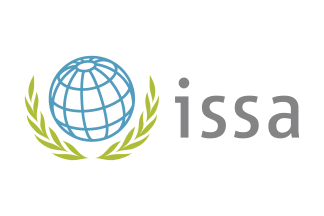
ISSA Flag
|
International Social Security Association
The International Social Security Association (ISSA) is the principal international institution bringing together social security agencies and organizations. The ISSA's aim is to promote dynamic social security as the social dimension in a globalizing world by supporting excellence in social security administration. It was founded in 1927, the ISSA has 340 member organizations in around 150 countries. It has its headquarters in Geneva, Switzerland, in the International Labour Office (ILO).
The ISSA provides information, research, expert advice and platforms for members to build and promote dynamic social security systems worldwide. The vision of dynamic social security provides a framework for the ISSA's action. In line with the mandate of the ISSA, dynamic social security ties improvements in social security outcomes to the capacities of social security institutions.
|
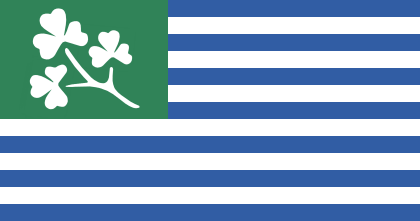
Irish American Partnership
|
Irish-American Partnership
The Irish-American Partnership is an organization which seeks to promote cooperation in all spheres between the Republic of Ireland and the United States.
It claims it main focus is to support educational opportunities, job creation, and cross-community projects in Ireland, both North and South, and the advancement of trustful business relations between the entire island and the United States, all in an effort to support peace and prosperity, North and South.
|
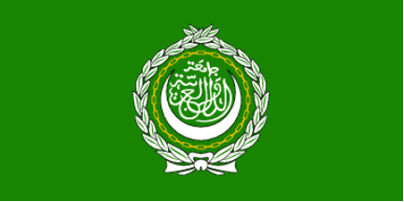
LAS Flag
|
League of Arab States
The Arab League, officially called the League of Arab States, is a regional organisation of Arab states in north and north-east Africa, and the Middle East. It was formed in Cairo in 1945 and currently has 22 members. The main goal of the league is to promote closer relations between member states and to co-ordinate collaboration between them, to safeguard their independence and sovereignty, and to consider in a general way the affairs and interests of Arab countries.
The League has a green flag with its emblem in the centre. The emblem comprises the name of the League in Arabic in white above a crescent moon with horns pointing upwards, all within a circle of 20 chain-links surrounded by a white wreath with a ribbon at the base. The links in the chain represent the number of countries that were members at the time the flag was adopted.
|
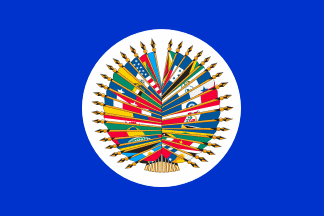
OAS Flag
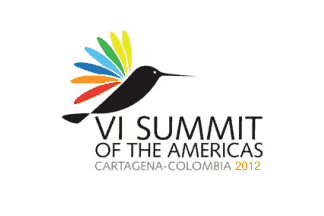
SOA VI Flag 2012
|
Organization of American States
The Organization of American States (OAS), or Organizacion de Estados Americanos (OEA) is a western hemisphere regional international organization headquartered in Washington, D.C. Its membership includes some thirty-four independent states of the Americas. Its purpose is to foster democracy, human rights, security, and development among its member states through political dialogue, inclusiveness, cooperation, and legal instruments in the Hemisphere.
The flag of the Organization of American States was first used during the term of office of Secretary General Jose Antonio Mora. The flag consists of the seal of the Organization, which represents the flags of all the member states on a royal blue background. In the center are the flags of all the member countries arranged in an arc with 10 flagpoles at the bottom, framed by a circle. The design was updated most recently in 1991, when Belize and Guyana became members of the Organization. Each time a new state joins, its flag is incorporated.
The Summits of the Americas (SOA) are a series of international summit meetings bringing together the leaders of countries in North America, Central America, South America and the Caribbean. The meetings provide an opportunity for discussions about a variety of issues and topics.
There have been several specially designed flags for these summit meetings, and the flag of VI Summit of the Americas is an example. Although officially scheduled to take place on April 14-15, 2012, there were additional events related to the Summit taking place as early as April 9. The flag is the SOA logo on a white horizontal background. "The hummingbird is native of the Americas and found from Alaska to Tierra del Fuego, it represents the vision of unity across the continent. The wide range of colors represents the diversity of the Americas."
|
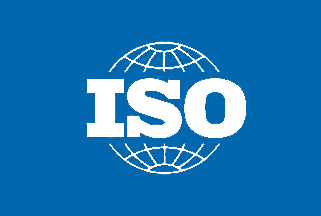
ISO Flag
|
International Standards Organization
The International Organization for Standardization (ISO) is an international-standard-setting body composed of representatives from various national standards organizations. Founded on February 23, 1947, the organization promulgates worldwide proprietary industrial and commercial standards. It has its headquarters in Geneva, Switzerland.
While ISO defines itself as a non-governmental organization, its ability to set standards that often become law, either through treaties or national standards, makes it more powerful than most non-governmental organizations. The ISO flag is usually in the form of table flags used at the International conferences.
|
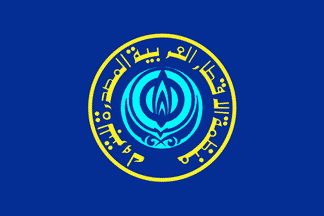
OAPEC Flag
|
Organization of Arab Petroleum Exporting Countries
The Organization of Arab Petroleum Exporting Countries (OAPEC) is a multi-governmental organization headquartered in Kuwait which coordinates energy policies in Arab nations. In 1968 three of Arab oil states Kuwait, Libya and Saudi Arabia agreed in Beirut to found OAPEC, aiming to separate oil production and sale from politics in the wake of the half-hearted 1967 oil embargo related to the Six Day War.
OAPEC is currently regarded as a regional specialized international organization and focuses on organizing cooperation on oil development, collective projects and regional integration. The organization has ten member states.
Its flag is dark blue with its logo in the center of the flag. |

OECD Flag (1961)
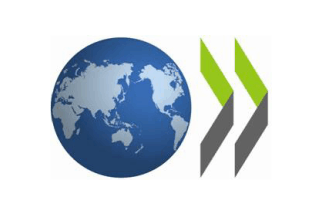
OECD Flag (2010)
|
Organization for Economic Co-operation and Development
Organisation de coopération et de développement économiques (OCDE)
The Organization for Economic Co-operation and Development (OECD) is an international economic organization of 34 countries founded in 1961 to stimulate economic progress and world trade. The mission of the Organization for Economic Co-operation and Development is to promote policies that will improve the economic and social well-being of people around the world. It defines itself as a forum of countries committed to democracy and the market economy, providing a platform to compare policy experiences, seeking answers to common problems, identifying good practices, and coordinating domestic and international policies of its members. Its headquartered in Paris, France.
The OECD feels that governments need to restore confidence in markets and the institutions and companies that make them function. That will require improved regulation and more effective governance at all levels of political and business life. These governments must re-establish healthy public finances as a basis for future sustainable economic growth and they need to ensure that people of all ages can develop the skills to work productively and satisfyingly in the jobs of tomorrow.
During celebration of 50th anniversary of its establishment in 2010, the OECD adopted a new logo and a new flag. New logo is a blue disc charged with white map of the continents (reducing the size of the Pacific Ocean), and the two green and grey colored arrowheads now point towards the fly instead of hoist, as they had on previous flag.
|
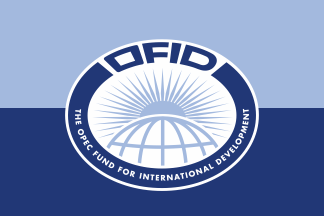
OFID Flag
|
OPEC Fund for International Development
The OPEC Fund for International Development (OFID) is a multilateral development finance institution established in 1976 by the Member Countries of the Organization of the Petroleum Exporting Countries (OPEC). Its objective is to reinforce financial cooperation between OPEC Member Countries and other developing countries, by providing financial support to the latter for their socio-economic development. The resources of OFID are also used to provide grants for food aid, technical assistance, research and similar intellectual activities. One of the institutions central aims is to advance South-South solidarity. The OFID has been headquartered in Vienna, Austria since 1976. It has 12 member states.
Its flag is horizontally divided, light blue and medium blue with its oval logo in the middle of the flag.
|
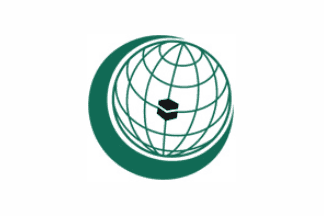
OIC Flag
|
Organization of the Islamic Cooperation
The Organization of the Islamic Cooperation (OIC) is the second largest inter-governmental organization in the world, after the United Nations. It has membership of 57 states spread over four continents. The Organization is the collective voice of the Muslim world and ensuring to safeguard and protect the interests of the Muslim world in the spirit of promoting international peace and harmony among various people of the world. The Organization was established after the summit of Arab leaders held in Rabat, Kingdom of Morocco on 25 September 1969. The official languages of the organisation are Arabic, English, and French.
The OIC changed its name from the "Organisation of the Islamic Conference" on June 28, 2011. Its administrative center is in Jeddah, Saudi Arabia.
|
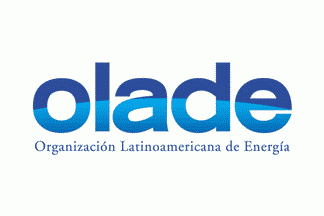
OLADE Flag
|
Latin American Energy Organization
Organización Latinoamericana de Energía
The Latin American Energy Organization (OLADE) is an intergovernmental organization created during the international energy crisis of the early seventies by the Latin America and the Caribbean countries. These countries lacked energy policies and needed to handle this crisis, thus, they began an intense political mobilization process that came to an end in November of 1973 with the signing of the Lima Agreement which formed OLADE, ratified by 26 countries in Latin America and the Caribbean.
Its flag is white with its logo in the middle of the flag, consisted of its blue abbreviation and its full Spanish name under it.
|
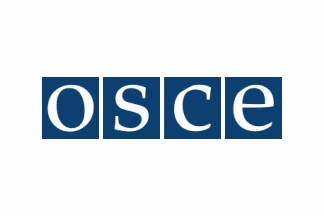
OSCE Flag
|
Organization for Security and Co-operation in Europe
The Organization for Security and Co-operation in Europe (OSCE) forms the largest regional security organization in the world. It addresses a wide range of security-related concerns, including arms control, confidence- and security-building measures, human rights, national minorities, democratization, policing strategies, counter-terrorism and economic and environmental activities.
The members of the OSCE are Albania, Andorra, Armenia, Austria, Azerbaijan, Belarus, Belgium, Bosnia and Herzegovina, Bulgaria, Canada, Croatia, Cyprus, Czech Republic, Denmark, Estonia, Finland, France, Georgia, Germany, Greece, Holy See, Hungary, Iceland, Ireland, Italy, Kazakhstan, Kyrgyzstan, Latvia, Liechtenstein, Lithuania, Luxembourg, Macedonia, Malta, Moldova, Monaco, Montenegro, Netherlands, Norway, Poland, Portugal, Romania, Russia, San Marino, , Slovakia, Slovenia, Spain, Sweden, Switzerland, Tajikistan, Turkey, Turkmenistan, Ukraine, United Kingdom, United States of America and Uzbekistan.
|
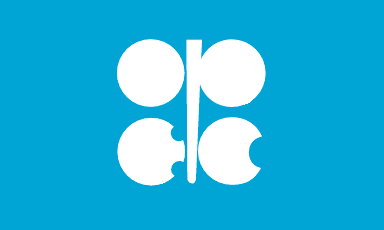
OPEC Flag
|
Organization of Petroleum Exporting Countries 1970
The Organization of the Petroleum Exporting Countries (OPEC) is an international Organization of eleven developing countries which are heavily reliant on oil revenues as their main source of income. Membership is open to any country which is a substantial net exporter of oil and which shares the ideals of the Organization. The current Members are Algeria, Indonesia, Iran, Iraq, Kuwait, Libya, Nigeria, Qatar, Saudi Arabia, the United Arab Emirates and Venezuela. OPEC's eleven Members collectively supply about 40 per cent of the world's oil output, and possess more than three-quarters of the world's total proven crude oil reserves.
The OPEC flag consists of a white OPEC logo on a light blue field. OPEC was founded in 1960 and the flag adopted in 1970.
|

PICP Flag
|
Pacific Islands Chiefs of Police
The Pacific Islands Chiefs of Police is a non-profit organization made up of police services in the Pacific. The PICP works to enhance and improve policing and communication in the Pacific by promoting and providing a voice on law enforcement issues and raising awareness of such issues with our stakeholders and provide a forum to share information and intelligence to counter transnational crime in the region.
The PICP originally started out as a South Pacific Chiefs of Police Conference (SPCPC) which had its first meeting in 1970 when representatives of seven Pacific Island countries met in Fiji. Over time the quantity of Chiefs/Commissioners attending grew and the organisation changed its name to Pacific Islands Chiefs of Police (PICP) in 2005 to reflect the PICP was more than just the hosting and arrangement of the conference and had wider pacific regional representation.
The PICP flag is blue with its logo on a white disc. The logo at the centre of the flag was first adopted by the then South Pacific Chiefs of Police Conference (SPCPC) in the 1980s. The P represents policing, the stars the Southern Cross, and the blue semi-circles signify waves that flow across the Pacific Ocean.
|
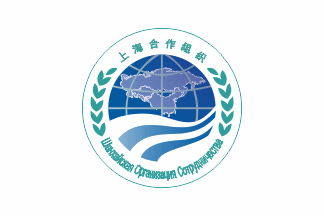
SCO Flag
|
Shanghai Cooperation Organization
The Shanghai Cooperation Organization is a permanent intergovernmental organization established in Shanghai in 2001. It currently has six member countries (People's Republic of China, Russian Federation, Republic of Kazakhstan, Republic of Kyrgyzstan, Republic of Tajikistan and Republic of Uzbekistan). Basically, it is a Chinese-Russian dominated organization dedicated to promoting joint political positions and coordinating military activities.
The SCO flag places the organization's logo on a white field. The logo is a greenish disc containing a blue stylized globe with the outlined territories of the member states appearing in its upper half and with three latitudinal and longitudinal lines showing, and its bottom half elided into the shape of three waves. The globe is surrounded by a green wreath and the organization's name written in Chinese above and Russian below the logo. Several variant versions of this flag exchange a turquoise-blue background (rather than the white one) on either the flag field or the logo itself.
|
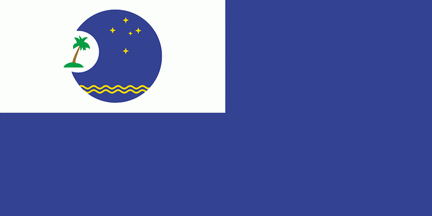
SPF Flag (1971)
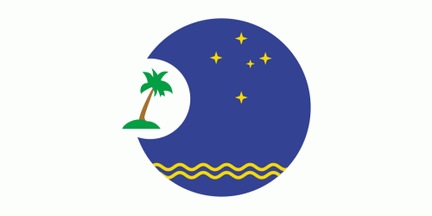
PIF Flag (2011)
|
Pacific Islands Forum
The Pacific Islands Forum, also called the South Pacific Forum, is an inter-governmental organization that aims to enhance cooperation between the independent countries of the Pacific Ocean. It was founded in 1971 as the "South Pacific Forum." In 1999, the name was changed to "Pacific Islands Forum" to be more inclusive of the Forum's Oceania-spanning membership of both north and south Pacific island countries and Australia. It is also an official observer at the United Nations.
The mission of Pacific Islands Forum is "to work in support of Forum member governments, to enhance the economic and social well-being of the people of the South Pacific by fostering cooperation between governments and between international agencies, and by representing the interests of Forum members in ways agreed by the Forum."
The original flag had a blue field, with white canton in which was centered the PIF emblem. In 2011 the flag was changed to a white flag with its logo centered in the field. Both flags seem to be now in use.
|
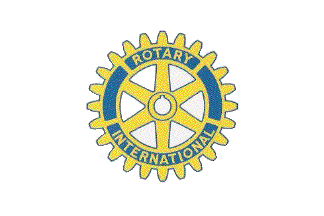
Rotary International Flag
|
Rotary International 1905
The Rotary Club is a service organization founded by Paul Harris in 1905, renamed Rotary International Association in 1913, and eventually Rotary International in 1926. Rotary International has today more than 1.2 million members and 31,500 clubs in 160 countries.
It seems that the official flag of the organization is white with the
emblem in the middle, although variant of the flag used some countries, Denmark and Finland, for example, has a yellow border.
|
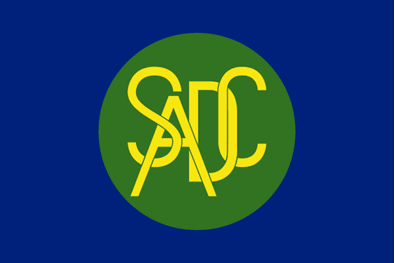
SADC Flag
|
Southern African Development Community
The Southern African Development Community (SADC) is an inter-governmental organization headquartered in Gaborone, Botswana which was established in August of 1992. SADC is the successor to the Southern African Development Coordinating Conference (SADCC) which was initially set up in 1980.
The SADC flag was officially launched in 1995 at the SADC Summit held in Kempton Park near Johannesburg, South Africa, and has a dark blue field with a green circle in the centre in which the SADC logo in gold is superimposed. The blue symbolises the sky and oceans which provide water for survival while green represents the region's rich flora and fauna as well as agricultural potential. The abundant mineral wealth of the region is represented by the gold lettering. |
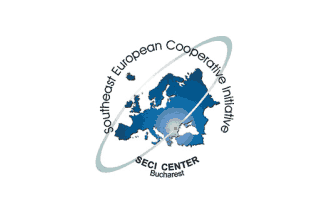
SECI Flag
|
Southeast European Cooperative Initiative
The Southeast European Cooperative Initiative is a regional initiative successfully providing stability in an unstable region and has found support in international organizations and countries. As of 2009, the region has found confidence in its new stability and along with the help of the SECI, has created a Regional Co-operation Council (RCC), owned and run by the countries in Southeast Europe aimed at strengthening peace, democracy and the economy in the hopes that the newfound stability can be supported by those countries who not so long ago were the perpetuators of volatility. The SECI Regional Center Headquarters is located in Bucharest Romania.
The SECI was originally composed of Albania, Bosnia and Herzegovina, Bulgaria, Macedonia, Greece, Hungary, Moldova, Romania, Yugoslavia, Croatia and Slovenia.
Its flag is white with its emblem in the middle of the flag. The emblem consists of blue map of Europe, overlapped with an oval ring, marked its seat (Bucharest) with a yellow star. There is the name of organization around the map, while its abbreviation and seat are placed under it. |
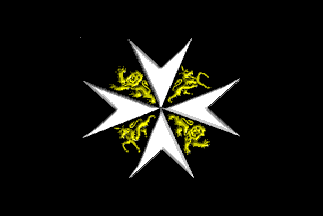
St. Johns Flag
|
St. John Ambulance
St John Ambulance is a common name used by a number of affiliated organisations in different countries dedicated to the teaching and practice of medical first aid and the provision of ambulance services, all of which derive their origins from the St John Ambulance Association founded in 1877 in the United Kingdom.
The St John Ambulance Flag is the Badge of the Order, that is, a white cross with gold lions and unicorns on a black field.
|
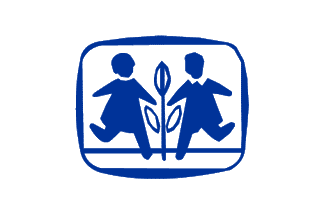
SOS Children's Villages Flag
|
SOS Children's Villages
SOS Children's Villages is an independent, non-governmental international development organisation which has been working to meet the needs and protect the interests and rights of children since 1949. It was founded by Hermann Gmeiner in Imst, Austria. The organization's work focuses on abandoned, destitute and orphaned children requiring family-based child care.
The flag of SOS Children's Villages is simply a blue emblem of two children and a flower, all dark blue, placed on a plain white field.
|
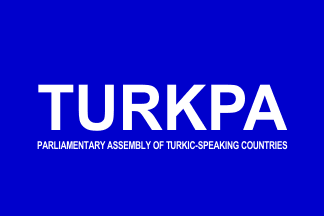
TÜRKPA Flag (Type #1)
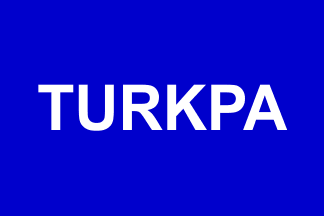
TÜRKPA Flag (Type #2)
|
Parliamentary Assembly of Turkic-speaking Countries Flag
The Parliamentary Assembly of Turkic-speaking Countries was established in 2008 by the Heads of parliaments of Azerbaijan, Kazakhstan, Kyrgyzistan, and Turkey.
According to the TÜRKPA accords its primary goals are the principles of independence; sovereignty; territorial and state boundaries integrity; legal equity, and mutual respect grounded on the principle of non-interference in internal affairs of each other.
They further hope to strengthen political and economic security of the member countries on the grounds of refrainment from threat or use of force or economic or any other pressure; growth of national prosperity by means of full and rational use of natural resources; endevour to the new progress in the sphere of parliamentary diplomacy, establishment of new relations and development of the existing ones with parliaments and other international organizations of the countries in the region and allover the world.
There are two variants of the TÜRKPA flag, both are blue with its abbreviation written with white capitals, but one has full name of the organization written under the abbreviation (Type #1), and the other does not. (Type #2)
|

TÜRKSOY Flag
|
International Organization of Turkic Culture
The International Organization of Turkic Culture (Uluslararasi Türk Kültürü Teskilati) is an international cultural organization of countries with Turkic populations, speaking languages belonging to the Turkic language family. TÜRKSOY was subsequently established by an agreement signed in 1993 in Almaty.
Members states and observers include: Azerbaijan, Kazakhstan, Kyrgyzistan, Uzbekistan, Turkey, Turkmenistan, Altai Republic, Bashkortostan, Gagauzia (Moldova), Khakassia, Northern Cyprus, Sakha (Yakutia), Tatarstan, and Tyva. In 1996, an official cooperation between TÜRKSOY and UNESCO was established, involving mutual consultations and reciprocal representation. It has been announced that TÜRKSOY will be integrated into the Turkic Council, a geopolitical organization of Turkic countries established in 2009.
The TÜRKSOY flag is white with its logo and names of the organization in Turkish and English below.
|
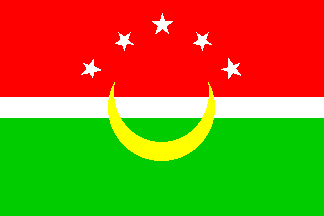
UAM Flag 1989
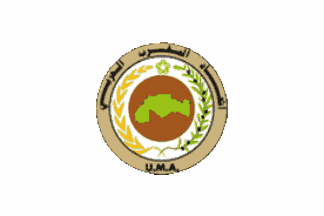
UAM Flag 2010
|
Arab Maghreb Union
The Union of Arab Maghreb first held a summit in Algiers (Algeria) in 2002. The Union was founded in 1989 and has five members: Algeria, Libya, Mauritania, Morocco and Tunisia. The Arab Maghreb Union is a trade agreement aiming for economic and some sort of future political unity in North Africa between the countries Morocco, Algeria, Tunisia, Libya, and Mauritania. The union is currently inactive and frozen, due to deep political disagreements between Morocco and Algeria.
The first flag of the Union was a horizontally divided red-white-green tricolor, with a yellow crescent pointing up in the middle of the flag and five white stars placed in an arc of circle above the crescent. The flag was adopted in 1990.
The Arab-Maghreb Union newest flag is white with its emblem in the center of the flag. The logo itself is a slightly modified version of the previous one. This flag was introduced in 2010.
|

UEMOA Flag
|
West African Monetary and Economic Union
Union économique et monétaire Ouest africaine
The West African Monetary and Economic Union (Union économique et monétaire Ouest africaine - UEMOA) is an organization of eight West African states including Benin, Burkina Faso, Côte d’Ivoire, Mali, Niger, Senegal, Togo, and Guinea-Bissau. Guinea-Bissau, a former Portuguese colony, is the only non-Francophone member state. It was established to promote economic integration among countries that share the CFA franc as a common currency, and acts as a customs union and currency union between its member states.
Current it is using a white flag with its logo on it, but the Heads of States of the members of UEMOA, holding a summit at Ouagadougou in March of 2009, have decided that the UEMOA should have a new flag, "to be displayed in each of the member states, beside the national flag," and its own anthem. Plans are underway to adopt a newer design.
|
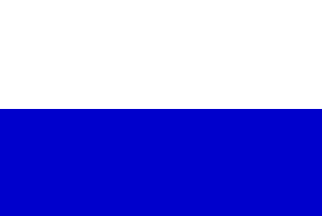
UfM Flag
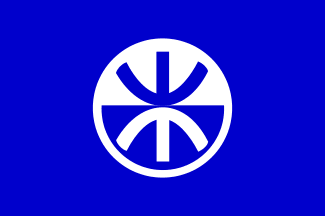
UfM Secretariat Flag
|
Union for the Mediterranean
The Union for the Mediterranean (Union pour la Méditerranée - UfM) is an inter-governmental organization with regional Euro-Mediterranean focus, which works alongside existing community institutions, with a co-presidency shared between the north and the south of the Mediterranean. The Union for the Mediterranean is inspired by the shared political will to revitalize efforts to transform the Mediterranean into an area of peace, democracy, cooperation and prosperity. It was founded in 2008 based on the initiative of French president Nicolas Sarkozy.
The Secretariat of the Union for the Mediterranean was created by the 43 Euro-Mediterranean Heads of State and Government in Paris. Foreign Affairs Ministers in their initial meeting in Marseille in 2008 decided that the headquarters of the Secretariat would be in Barcelona, Spain. The creation of a joint secretariat was a key stone in this partnership. The Secretariat was established to reinforce Mediterranean relations and achieving visibility through joint economic projects.
The flag of the Union for the Mediterranean is a white over blue bicolor, adopted in 2008. The upper white stripe symbolizes the sky, the lower is blue, symbolizing the sea. The UfM Secretariat also has its own flag. It is blue with secretariat logo in the middle placed on a white disc.
|
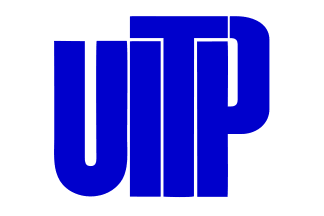
UITP Flag
|
International Association of Public Transport
The UITP International Association of Public Transport (L’Union internationale des transports publics) is an organization for public transport authorities and operators, policy makers, scientific institutes and the public transport supply and service industry. UITP represents an international network of 3,400 members located in 92 countries and covers all modes of public transport - metro, bus, light rail, railways, and waterborne transportion.
The UITP's General Secretariat has a main office in Brussels and eleven regional and liaison offices worldwide (Abidjan, Bangalore, Canberra, Dubai, Hong Kong, Istanbul, Johannesburg, Moscow, Rome, Săo Paulo, and Tehran). The UITP flag is a white flag with its logo, which is formed by blue abbreviation of UITP.
|
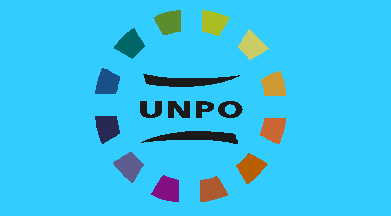
UNPO Flag
|
Unrepresented Nations and Peoples Organization
The Unrepresented Nations and Peoples Organization (UNPO) is an international organization created by nations and peoples around the world, who are not represented as such in the world´s principal international organizations, such as the United Nations. Founded in 1991, UNPO today consists of over 50 members who represent over 100 million persons.
UNPO offers an international forum for occupied nations, indigenous peoples, minorities, and even oppressed majorities who currently struggle to regain their lost countries, preserve their cultural identities, protect their basic human and economic rights and safeguard the natural environment.
|
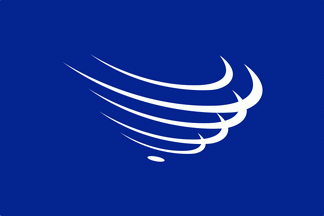
UNASUR Flag
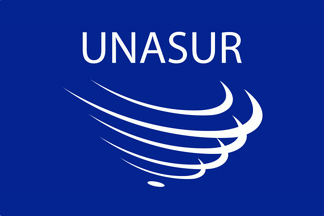
UNASUR Flag (variant)
|
Union of South American Nations
The Union of South American Nations (Unión de Naciones Suramericanas - UNASUR) is an inter-governmental union modeled on the European Union. At its founding many envision UNASUR would function similarly to the European Union by helping to coordinate defense across the continent and creating a common South American currency. Unasur has administrative headquarters in Quito, Ecuador. The 12 member states are Argentina, Bolivia, Brazil, Chile, Colombia, Ecuador, Guyana, Paraguay, Peru, Suriname, Uruguay and Venezuela. Mexico and Panama attend meetings as observers.
According to the South American Union of Nations Constitutive Treaty, UNASUR goals are "to build, in a participatory and consensual manner, an integration and union among its peoples in the cultural, social, economic and political fields, prioritizing political dialogue, social policies, education, energy, infrastructure, financing and the environment, among others, with a view to eliminating socioeconomic inequality, in order to achieve social inclusion and participation of civil society, to strengthen democracy and reduce asymmetries within the framework of strengthening the sovereignty and independence of the States."
UNASUR has two flags, one with their emblem and lettering, one with just the emblem. Both are white on a blue field. |
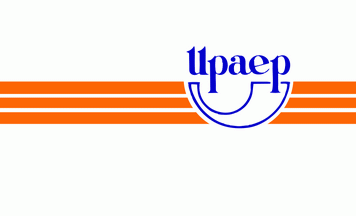
UPAEP Flag
|
Postal Union of the Americas, Spain and Portugal
The Postal Union of the Americas, Spain and Portugal (Unión Postal de las Américas, España y Portugal) is an intergovernmental organization, gathering at present 27 State Members, with headquarters in Montevideo, in Uruguay. Established in 1911 under the designation South America Postal Union, this Organization has amended successively its scope and designation, at first with the enlargement across the whole American territory.
UPAEP’s mission comprises the constant improvement of the postal services of its member countries, facilitating the exchange of experiences and the operation of concerted action between postal bodies, and implementing international cooperation initiatives, always bearing in mind the promotion of postal interchange, at national and international level, an action governed by guarantees regarding security, regularity, speed and economy.
|

UNASUR-SADC Flag
|
South American Defense Council
The South American Defense Council (Consejo de Defensa Suramericano) is made up of the defense ministers of UNASUR's 12 country members, who meet regularly to strengthen regional cooperation on defense issues. The creation of South American Defense Council (SADC) was approved in 2008 at a summit conference held in Brazil.
The SADC flag is light-blue charged with map of South America covered by the UNASUR logo. There is the Spanish name of the Council over the emblem, while name of UNASUR is placed under the map.
|

WCO Flag
|
World Customs Organization
The World Customs Organization (WCO) was founded in 1952 as the Customs Cooperation Council (CCC), but in 1994 the name was changed to World Customs Organization. The WCO logo symbolizes the countries of the world cradled and brought together by the arms of the Customs Co-operation Council.
Today, the World Customs Organization (WCO) is an intergovernmental organization headquartered in Brussels, Belgium. With its worldwide membership, the WCO is recognized as the voice of the global customs community.
|
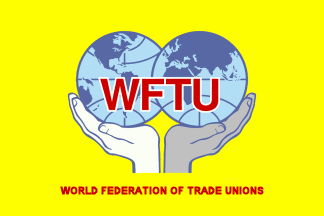
WFTU Flag
|
World Federation of Trade Unions 1945
"The World Federation of Trade Unions (WFTU) was formed in Paris in 1945 and was attended by delegates representing 67 million workers from 56 national organisations from 55 countries and 20 international organisations. Among the original aims of the WFTU is to "combat war and the causes of war and work for a stable and enduring peace." Other founding resolutions are the right for workers to organise themselves, freedom from discrimination on race, creed colour or sex, the right to work and to paid holidays, living wages and social security to guarantee against unemployment, in sickness, accidents and old age.
The WFTU today continues to represent millions of workers around the globe in class based trade unionism.
|
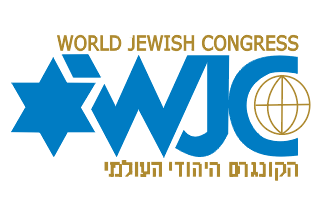
WJC Flag
|
World Jewish Congress
The World Jewish Congress (WJC) is a political organization whose membership is composed exclusively of representatives from organized Jewish communities in countries around the world. Although it is not a specifically religious organization, among its concerns are and have been any infringements of the right of Jews to practice their religion as well as to participate fully in various social, cultural, and educational activities which are related both to the practice of the Jewish religion and to the right to live a secular, albeit Jewish, life.
It also is concerned with mobilizing a global response to anti-Semitism wherever it may occur.
|
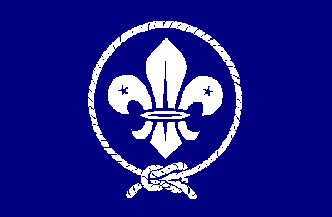
WOSM Flag
|
World Organization of the Scout Movement
The World Organization of the Scout Movement (WOSM) is an international, non-governmental organization composed of all recognized national Scout organizations. Its governing body is the World Conference, which meets every three years, and its executive is the World Committee composed of elected volunteers. It is headquartered in Switzerland. This flag is not the flag of any one country's Scouting association, it represents all Scouting associations.
The flag is royal purple with the white fleur-de-lis and rope; the two stars on the flag allude to truth and knowledge, the two most important elements found in the creeds, promises and oaths of all member organizations. There are more than 28 million Scouts, young people and adults, male and female, in 216 countries and territories. |
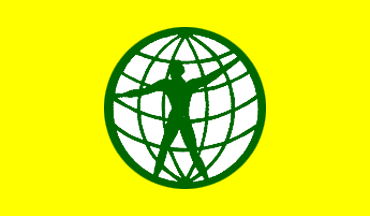
World Citizen Flag
|
World Service Authority
The World Service Authority. (WSA), founded in 1953, is a non-profit organization that educates about and promotes "world citizenship," "world law," and World Government. It is best known for issuing World Passports.
The WSA was founded by Garry Davis, a former Broadway actor and World War II bomber pilot, who renounced his U.S. citizenship in 1948 to live as a "citizen of the world." It was set up to be the administrative agency of the "World Government of World Citizens" which he declared in 1953. Besides issuing World Passports, the WSA registers applicants as "world citizens" and issues "world citizen" identity documents, such as birth certificates, identity cards, and marriage certificates.
|
Flags of International and Multi-National Sports Organizations
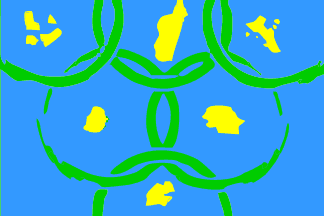
CJSOI Flag
|
Commission on Youth and Sports of the Indian Ocean
The Commission on Youth and Sports of the Indian Ocean (Commission de la Jeunesse et des Sports de l'Océan Indien) was founded in 1988. The CJSOI Games were introduced in 1994 and held every two years. Their purpose is to enable youth aged between 14 and 17 years participate in international sporting events as well as promote cultural exchanges amongst the member islands/countries of the Indian Ocean. Participating countries are: Comoros, Djibouti, Madagascar, Mauritius, Mayotte, Reunion and the Seychelles.
The CJSOI flag is blue with yellow maps of member states surrounded by green circles.
|
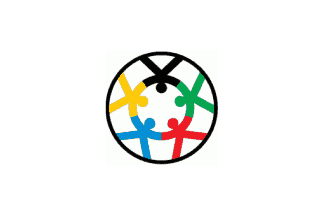
IMGA Flag
|
International Masters Games Association
The International Masters Games Association is the worldwide representative
body for Masters sport. Recognised by the International Olympic Committee, the International Masters Games Association aims to support the Olympic movement and promote the sport-for-all philosophy of the Olympic Charter by encouraging all people beyond young adulthood to play sport and to participate in Masters Games with the awareness that competitive sport can continue throughout life and improve personal fitness.
The IMGA flag is white with black outlined disc emblem formed by five humanoids in Olympic colours.
|
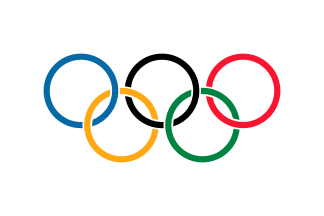
IOC/CIO Flag
|
International Olympic Committee
Comité International Olympique (CIO)
The Olympic Games are the world's largest international competion, featuring both Summer and Winter games, in which thousands of athletes participate in a variety of competitions. The Games are currently held every two years, with Summer and Winter Olympic Games alternating, so the seasonal games occur every four years.
The Olympic flag with its white field and five interlaced rings of blue, yellow, black, green, and red is probably one of the most recognized sports flags in the world. In 1913, the five rings first appeared at the top of a letter written by Pierre de Coubertin. He drew the rings and coloured them in by hand. He presented the completed flag design in 1914 in Paris at a meeting of the Olympic Congress.
|

South Pacific Games 1963

South Pacific Games 1966
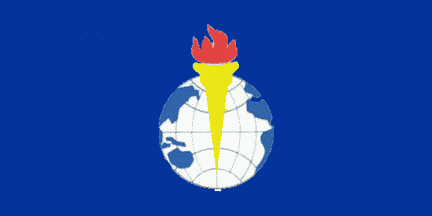
South Pacific Games 2007
|
The Pacific Games
The Pacific Games, formerly the South Pacific Games, is a multi-sport event, like the Olympics, but on a much smaller scale, with participation exclusively from countries around the South Pacific. It is held every four years and began in 1963.
The Pacific Games Council is the governing body of the games. With expansion and economic growth in the Pacific and Oceania countries of the Pacific Islands it was appropriate for the South Pacific Games Council to modernise and revise its charter in light of changes in the region and the changing place of Sport in society, thus the council adapted a new charter in 2007 and a new flag in 2008.
|
|
|
Pacific Games 2008 |
|
Pacific Games Council 2008 |
This new logo and new flags were introduced in 2008. The flag is white with a blue wavy line and three discs over it representing three major regions of the Pacific.
|
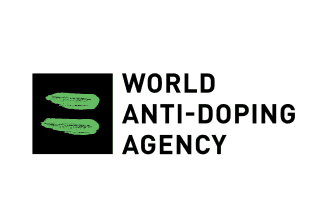
WADA Flag
|
World Anti-Doping Agency
Agence mondiale antidopage
The World Anti-Doping Agency is an independent foundation created through a collective initiative led by the International Olympic Committee (IOC). It was founded in 1999, in Lausanne, Switzerland, as a result of what was called the "Declaration of Lausanne," to promote, coordinate and monitor the fight against drugs in sport. The WADA is an international independent agency composed and funded equally by the sport movement and governments of the world. Its key activities include scientific research, education, development of anti-doping capacities, and monitoring of the World Anti Doping Code - the document harmonizing anti-doping policies in all sports and all countries.
The World Anti-Doping Agency has been headquartered in Montreal, Canada, since 2001. Its flag is white with its logo in the middle of the flag. The logo is a black square with two green seeds, and the name of organization in black letters.
|
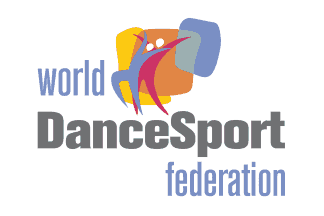
WDSF Flag
|
World DanceSport Federation
The World DanceSport Federation is the world governing body for DanceSport. It was founded 1957 under the name International Council of Amateur Dancers in Wiesbaden, Germany, and is now a non-governmental international organisation. The mission of WDSF is to regulate, administer
and develop DanceSport for the benefit of millions of athletes at every level and on all continents.
It changed its name into International DanceSport Federation (IDSF) in 1990, but the current name was adopted in 2011 to emphasise the global character of the organization.
The WDSF flag is white with its logo in the center of the flag. The previous IDSF flag was similar, but with former name.
|
| Top of This Page | International Code of Signals | North Atlantic Treaty Organization | United Nations |
|